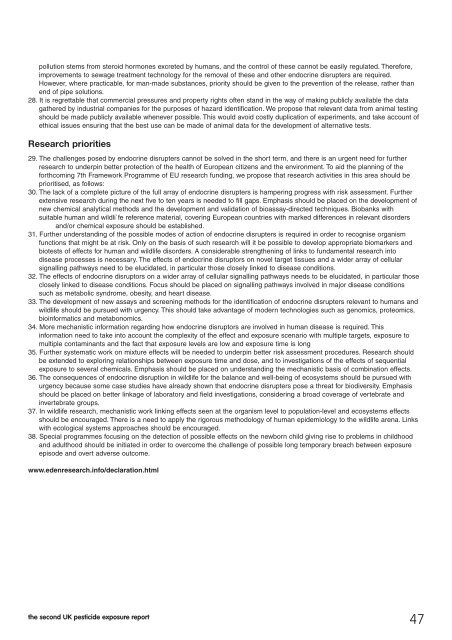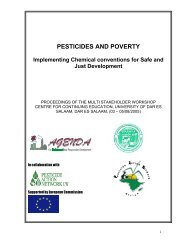Your Daily Poison - Pesticide Action Network UK
Your Daily Poison - Pesticide Action Network UK
Your Daily Poison - Pesticide Action Network UK
You also want an ePaper? Increase the reach of your titles
YUMPU automatically turns print PDFs into web optimized ePapers that Google loves.
pollution stems from steroid hormones excreted by humans, and the control of these cannot be easily regulated. Therefore,<br />
improvements to sewage treatment technology for the removal of these and other endocrine disrupters are required.<br />
However, where practicable, for man-made substances, priority should be given to the prevention of the release, rather than<br />
end of pipe solutions.<br />
28. It is regrettable that commercial pressures and property rights often stand in the way of making publicly available the data<br />
gathered by industrial companies for the purposes of hazard identification. We propose that relevant data from animal testing<br />
should be made publicly available whenever possible. This would avoid costly duplication of experiments, and take account of<br />
ethical issues ensuring that the best use can be made of animal data for the development of alternative tests.<br />
Research priorities<br />
29. The challenges posed by endocrine disrupters cannot be solved in the short term, and there is an urgent need for further<br />
research to underpin better protection of the health of European citizens and the environment. To aid the planning of the<br />
forthcoming 7th Framework Programme of EU research funding, we propose that research activities in this area should be<br />
prioritised, as follows:<br />
30. The lack of a complete picture of the full array of endocrine disrupters is hampering progress with risk assessment. Further<br />
extensive research during the next five to ten years is needed to fill gaps. Emphasis should be placed on the development of<br />
new chemical analytical methods and the development and validation of bioassay-directed techniques. Biobanks with<br />
suitable human and wildli`fe reference material, covering European countries with marked differences in relevant disorders<br />
and/or chemical exposure should be established.<br />
31. Further understanding of the possible modes of action of endocrine disrupters is required in order to recognise organism<br />
functions that might be at risk. Only on the basis of such research will it be possible to develop appropriate biomarkers and<br />
biotests of effects for human and wildlife disorders. A considerable strengthening of links to fundamental research into<br />
disease processes is necessary. The effects of endocrine disruptors on novel target tissues and a wider array of cellular<br />
signalling pathways need to be elucidated, in particular those closely linked to disease conditions.<br />
32. The effects of endocrine disruptors on a wider array of cellular signalling pathways needs to be elucidated, in particular those<br />
closely linked to disease conditions. Focus should be placed on signalling pathways involved in major disease conditions<br />
such as metabolic syndrome, obesity, and heart disease.<br />
33. The development of new assays and screening methods for the identification of endocrine disrupters relevant to humans and<br />
wildlife should be pursued with urgency. This should take advantage of modern technologies such as genomics, proteomics,<br />
bioinformatics and metabonomics.<br />
34. More mechanistic information regarding how endocrine disruptors are involved in human disease is required. This<br />
information need to take into account the complexity of the effect and exposure scenario with multiple targets, exposure to<br />
multiple contaminants and the fact that exposure levels are low and exposure time is long<br />
35. Further systematic work on mixture effects will be needed to underpin better risk assessment procedures. Research should<br />
be extended to exploring relationships between exposure time and dose, and to investigations of the effects of sequential<br />
exposure to several chemicals. Emphasis should be placed on understanding the mechanistic basis of combination effects.<br />
36. The consequences of endocrine disruption in wildlife for the balance and well-being of ecosystems should be pursued with<br />
urgency because some case studies have already shown that endocrine disrupters pose a threat for biodiversity. Emphasis<br />
should be placed on better linkage of laboratory and field investigations, considering a broad coverage of vertebrate and<br />
invertebrate groups.<br />
37. In wildlife research, mechanistic work linking effects seen at the organism level to population-level and ecosystems effects<br />
should be encouraged. There is a need to apply the rigorous methodology of human epidemiology to the wildlife arena. Links<br />
with ecological systems approaches should be encouraged.<br />
38. Special programmes focusing on the detection of possible effects on the newborn child giving rise to problems in childhood<br />
and adulthood should be initiated in order to overcome the challenge of possible long temporary breach between exposure<br />
episode and overt adverse outcome.<br />
www.edenresearch.info/declaration.html<br />
the second <strong>UK</strong> pesticide exposure report 47

















